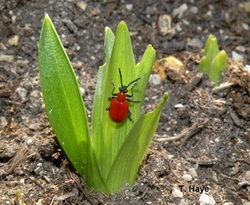
A very stiking but exceedingly destructive bug, the Lily Leaf Beetle was accidently introduced into North American via Montreal in 1943 and has been increasing in numbers and spreading across Canada and the United States ever since.
The lily leaf beetle lays eggs and completes its life cycle exclusively on true
lilies (daylilies are not affected). Oriental, rubrum, tiger and trumpet lilies as well as Oriental trumpets and native North American lily species are all vulnerable. It seems the beetle prefers some types more than others. Research shows that Asiatic lilies are the most vulnerable, while some Oriental lilies are more resistant.
The adults will also eat the leaves of some other garden plants, including lily-of-the-valley, solomon's seal, potato, flowering tobacco, hollyhock and hosta.
Both the adult and juvenile phases are voracious feeders and they can do a lot of damage in a very short time. Your lilies should be carefully examined several times a week, beginning as soon as the plants emerge from the ground. The adult beetles overwinter in the soil or in plant debris, and will begin laying their eggs early in the growing season. A single female can lay up to 450 eggs ranging in color from red-brown to orange, in narrow straight rows on the underside of the leaf. The eggs will then hatch in one to two weeks.
A new site has been created to help track the movement of this beetle and we ask that if you or anyone you know has seen or being attacked by this notorious insect to Contact Us immediately and/or visit the Lily Leaf Beetle Tracker.
Let's keep our lily populations safe!
The lily leaf beetle lays eggs and completes its life cycle exclusively on true
lilies (daylilies are not affected). Oriental, rubrum, tiger and trumpet lilies as well as Oriental trumpets and native North American lily species are all vulnerable. It seems the beetle prefers some types more than others. Research shows that Asiatic lilies are the most vulnerable, while some Oriental lilies are more resistant.
The adults will also eat the leaves of some other garden plants, including lily-of-the-valley, solomon's seal, potato, flowering tobacco, hollyhock and hosta.
Both the adult and juvenile phases are voracious feeders and they can do a lot of damage in a very short time. Your lilies should be carefully examined several times a week, beginning as soon as the plants emerge from the ground. The adult beetles overwinter in the soil or in plant debris, and will begin laying their eggs early in the growing season. A single female can lay up to 450 eggs ranging in color from red-brown to orange, in narrow straight rows on the underside of the leaf. The eggs will then hatch in one to two weeks.
A new site has been created to help track the movement of this beetle and we ask that if you or anyone you know has seen or being attacked by this notorious insect to Contact Us immediately and/or visit the Lily Leaf Beetle Tracker.
Let's keep our lily populations safe!

 RSS Feed
RSS Feed